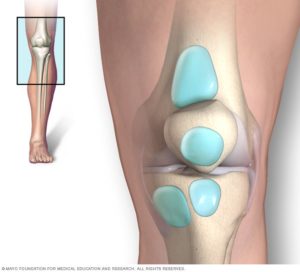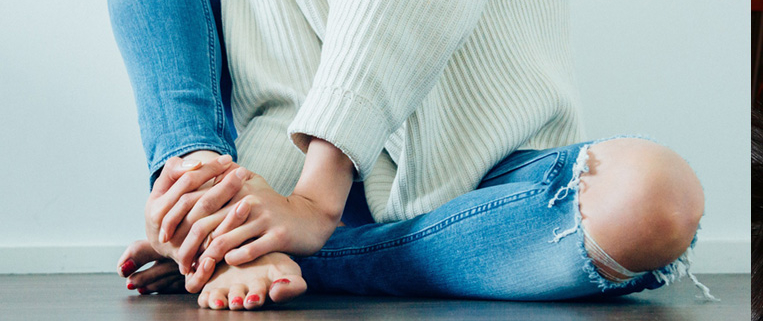How to tell if you have Bursitis in your Knee
Article Featured on Medicine.net
Find out about knee bursitis, inflammation of one of the three fluid-filled sacs (bursae) due to injury or strain. Symptoms include pain, swelling, warmth, tenderness, and redness. Read about treatment, causes, and home remedies.
Knee bursitis facts
- A bursa is a fluid-filled sac that functions as a gliding surface to reduce friction between moving tissues of the body.
- There are three major bursae of the knee.
- Localized swelling, warmth, and tenderness, as well as knee pain, often accompany bursitis of the knee.
- Bursitis is usually not infectious, but the bursa can become infected.
- Treatment of noninfectious bursitis includes rest, ice, and medications for inflammation and pain. Infectious bursitis is treated with antibiotics, aspiration, and surgery.

What is bursitis?
A bursa is a closed, fluid-filled sac that functions as a gliding surface to reduce friction between tissues of the body. Bursae is plural for bursa. The major bursae are located adjacent to the tendons near the large joints, such as the shoulders, elbows, hips, and knees. When a bursa becomes inflamed, the condition is known as bursitis. This can cause swelling, warmth, and tenderness in the affected area. Most commonly, bursitis is caused by local soft-tissue trauma or strain injury, and there is no infection (aseptic bursitis). On rare occasions, particularly when the immune system is suppressed, the bursa can become infected with bacteria. This condition is called septic bursitis.
What is knee bursitis?
The knee joint is surrounded by three major bursae. At the tip of the knee, over the kneecap bone (patella), is the prepatellar bursa. This bursa can become inflamed (prepatellar bursitis) from direct trauma to the front of the knee. This commonly occurs when maintaining a prolonged kneeling position, thereby causing irritation of the prepatellar area. It has been referred to as “housemaid’s knee,” “roofer’s knee,” and “carpet layer’s knee,” based on the patient’s associated occupational histories.
Strain of the large tendon below the kneecap can cause both tendonitis and infrapatellar bursitis. This bursa of the knee is located just under the kneecap beneath the large tendon that attaches the muscles in front of the thigh and the kneecap to the prominent bone in front of the lower leg. This bursa is called the infrapatellar bursa, and when inflamed, the condition is called infrapatellar bursitis. It is commonly seen with inflammation of the adjacent tendon as a result of a jumping injury, hence the name “jumper’s knee.”
Inflammation of the bursa at the inner side of the knee (anserine area) can cause pes anserine bursitis. Pes anserine bursitis causes local tenderness of the inner knee. This bursa of the knee is located on the lower inner side of the knee and is called the “anserine bursa.” This bursa most commonly becomes inflamed in middle-aged women. This condition is referred to as anserine bursitis. Anserine bursitis is particularly common in those who are obese. These patients can notice pain in the inner knee while climbing or descending stairs.
What are causes of knee bursitis?
Bursitis of the knee can occur when the bursa fills with blood from injury and overuse, such as from athletic competition. Bursitis can also occur from rheumatoid arthritis and from deposits of crystals, as seen in patients with gouty arthritis and pseudogout. The prepatellar bursa can also become infected with bacteria (septic bursitis). When this happens, fever may be present. This type of infection usually occurs from breaks in the overlying skin or puncture wounds. The bacterium involved in septic bursitis of the knee is usually Staphylococcus, which is normally present on the skin. Rarely, a chronically inflamed bursa can become infected by bacteria spreading through the blood.
What are knee bursitis symptoms and signs?
Bursitis can lead to varying degrees of swelling, warmth, tenderness, and redness in the overlying area of the knee. As compared with knee joint inflammation (arthritis), it is usually only mildly painful. It is frequently associated with increased pain when kneeling and can cause stiffness and pain with walking. Also, in contrast to problems within the knee joint, the range of motion of the knee is frequently preserved and the swelling is outside of the joint.
How do health care professionals diagnose knee bursitis?
Bursitis of the knee is diagnosed based upon the typical location of a bursa displaying signs of inflammation including knee pain, tenderness, stiffness, and sometimes redness and warmth. Typically, there is point tenderness at the site of the inflamed bursa.
What is the treatment for prepatellar bursitis of the knee? Are there home remedies for knee bursitis?
The treatment of any bursitis depends on whether or not it involves infection. Non-infectious (aseptic) prepatellar bursitis can be treated with ice compresses, rest, and anti-inflammatory and pain medications. When ice packs and anti-inflammatory drugs are not effective, knee bursitis can require aspiration of the bursa fluid and/or a local cortisone injection. This procedure involves removal of the fluid with a needle and syringe under sterile conditions and can be performed in the doctor’s office. Sometimes the fluid is sent to the laboratory for further analysis. Noninfectious knee bursitis can also be treated with an injection of cortisone medication into the swollen bursa. Cortisone injections are sometimes done at the same time as the aspiration procedure.
Septic bursitis requires even further evaluation and treatment. The bursal fluid can be examined in the laboratory to identify the microbes causing the infection. It requires antibiotic therapy, often intravenously. Repeated aspiration of the inflamed fluid may be required. Surgical drainage and removal of the infected bursa sac (bursectomy) may also be necessary.
What is the prognosis (outlook) of knee bursitis?
The outlook for knee bursitis is generally very good. Mild bursitis resolves spontaneously with rest. More significant bursitis can require medications (either taken by mouth or locally injected) to reduce inflammation. Infectious bursitis requires drainage, possibly surgical resection, and antibiotics.
Is it possible to prevent knee bursitis?
To the extent that the bursitis is caused by injury or athletic activity, it can be prevented by avoiding reinjury to the bursa and adjacent tissues.
Orthopedic & Sports Medicine Center of Oregon is an award-winning, board-certified orthopedic group located in downtown Portland Oregon. We utilize both surgical and nonsurgical means to treat musculoskeletal trauma, spine diseases, sports injuries, degenerative diseases, infections, tumors and congenital disorders.
Our mission is to return our patients back to pain-free mobility and full strength as quickly and painlessly as possible using both surgical and non-surgical orthopedic procedures.
Our expert physicians provide leading-edge, comprehensive care in the diagnosis and treatment of orthopedic conditions, including total joint replacement and sports medicine. We apply the latest state-of-the-art techniques in order to return our patients to their active lifestyle.
If you’re looking for compassionate, expert orthopedic surgeons in Portland Oregon, contact OSM today.
Phone:
503-224-8399
Address
1515 NW 18th Ave, 3rd Floor
Portland, OR 97209
Hours
Monday–Friday
8:00am – 4:30pm



